15 galaxy cantik di alam semesta
...... 15 GalaxY Tercantik .....
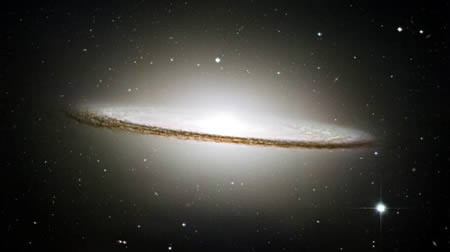
The Sombrero Galaxy is an unbarred spiral galaxy in the constellation Virgo. It has a bright nucleus, an unusually large central bulge, and a prominent dust lane in its inclined disk. The dark dust lane and the bulge give this galaxy the appearance of a sombrero. The galaxy has an apparent magnitude of +9.0, making it easily visible with amateur telescopes. The large bulge, the central supermassive black hole, and the dust lane all attract the attention of professional astronomers.

The Black Eye Galaxy was discovered by Edward Pigott in March 1779, and independently by Johann Elert Bode in April of the same year, as well as by Charles Messier in 1780. It has a spectacular dark band of absorbing dust in front of the galaxy's bright nucleus, giving rise to its nicknames of the "Black Eye" or "Evil Eye" galaxy. M64 is well known among amateur astronomers because of its appearance in small telescopes. It is a spiral galaxy in the Coma Berenices constellatio

The galaxy was discovered by Caroline Herschel in 1783 while doing one of her systematic comet searches.About a half century later, John Herschel while at the Cape of Good Hope observed it using his 18 inch metallic mirror reflector. He then wrote "very bright and large (24′ in length); a superb object.... Its light is somewhat streaky, but I see no stars in it except 4 large and one very small one, and these seem not to belong to it, there being many near..."
In 1961, Allan Sandage wrote in the Hubble Atlas of Galaxies that the Sculptor Galaxy is "the prototype example of a special subgroup of Sc systems....photographic images of galaxies of the group are dominated by the dust pattern. Dust lanes and patches of great complexity are scattered throughout the surface. Spiral arms are often difficult to trace.... The arms are defined as much by the dust as by the spiral pattern." B. Y. Mills, working out of Sydney, discovered that the Sculptor Galaxy is also a fairly strong radio source.In 1998 the hubble space telescope took a close up of NGC 253.
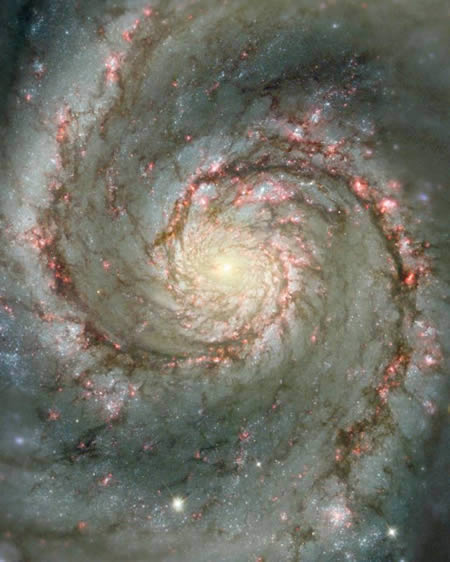
The Whirlpool Galaxy is an interacting grand-design spiral galaxy located at a distance of approximately 23 million light-years in the constellation Canes Venatici. It is one of the most famous spiral galaxies in the sky.[citation needed] The galaxy and its companion (NGC 5195) are easily observed by amateur astronomers, and the two galaxies may even be seen with binoculars.The Whirlpool Galaxy is also a popular target for professional astronomers, who study it to further understanding of galaxy structure (particularly structure associated with the spiral arms) and galaxy interactions.

NGC 3310 is a grand design spiral galaxy in the constellation Ursa Major. It is a starburst galaxy and its likely that NGC 3310 collided with one of its satellite galaxies about 100 million years ago, triggering widespread star formation. It is believed to be located approximately 46 million light-years away from the Earth, and is thought to be about 22000 light-years wide.
The ring clusters of NGC 3310 have been undergoing starburst activity for at least the last 40 Myr.

SN 1987A was a supernova in the outskirts of the Tarantula Nebula in the Large Magellanic Cloud, a nearby dwarf galaxy. It occurred approximately 51.4 kiloparsecs from Earth, close enough that it was visible to the naked eye. It could be seen from the Southern Hemisphere. It was the closest observed supernova since SN 1604, which occurred in the Milky Way itself. The light from the supernova reached Earth on February 23, 1987. As the first supernova discovered in 1987, it was labeled "1987A". Its brightness peaked in May with an apparent magnitude of about 3 and slowly declined in the following months. It was the first opportunity for modern astronomers to see a supernova up close.

NGC 1512 is a barred spiral galaxy about 30 million light-years away in the constellation Horologium. It is a member of the Dorado Group
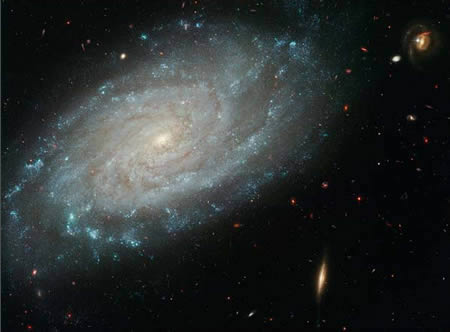
NGC 3370 nick named Silverado Galaxy is a spiral galaxy about 98 million light-years away in the constellation Leo. It is similar in size to our own Milky Way. NGC 3370 exhibits intricate spiral arm structure that is sprinkled with hot areas where new stars are forming. NGC 3370's center has well defined dust lanes and an unusually ill-defined nucleus. This galaxy contains a combination of young stars in the bluer regions and older stars in the yellowish core. The mass of NGC 3370 is estimated to be about the same as our own Milky Way at around 1011 solar masses.

Messier 81 (also known as NGC 3031 or Bode's Galaxy) is a spiral galaxy about 12 million light-years away in the constellation Ursa Major. M81 is one of the most striking examples of a grand design spiral galaxy, with near perfect arms spiraling into the very center. Because of its proximity to Earth, its large size, and its active galactic nucleus (which harbors a supermassive black hole) Messier 81 is a popular galaxy to study in professional astronomy research. The galaxy's large size and relatively low apparent magnitude (lower magnitude implies higher brightness) also make it a popular target for amateur astronomy observations.
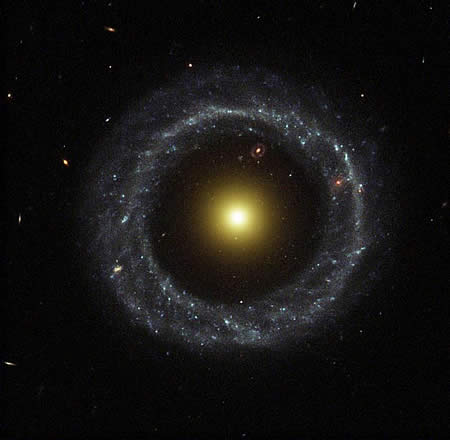
Hoag's Object is a non-typical galaxy of the type known as a ring galaxy. The appearance of this object has interested amateur astronomers as much as its uncommon structure has fascinated professionals. The galaxy is named after Arthur Allen Hoag who discovered it in 1950 and identified it as either a planetary nebula or a peculiar galaxy with 8 billion stars.

The Antennae Galaxies are a pair of interacting galaxies in the constellation Corvus. They were both discovered by Friedrich Wilhelm Herschel in 1785.
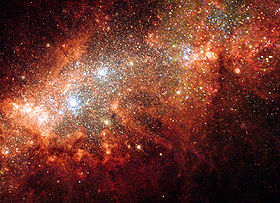
A starburst galaxy is a galaxy in the process of an exceptionally high rate of star formation, compared to the usual star formation rate seen in most galaxies. Galaxies are often observed to have a burst of star formation after a collision or close encounter between two galaxies. The rate of star formation is so great for a galaxy undergoing a starburst that, if the rate was sustained, the gas reservoirs from which stars are formed would be used up on timescales much shorter than that of the galaxy. For this reason, it is presumed that starbursts are temporary. Well-known starburst galaxies include M82, NGC 4038/NGC 4039 (the Antennae Galaxies), and IC 10.
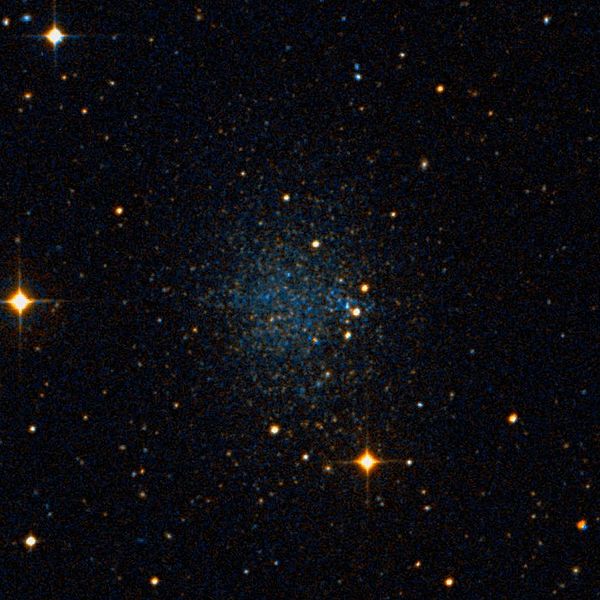
A dwarf galaxy is a small galaxy composed of up to several billion stars, a small number compared to our own Milky Way's 200-400 billion stars. The Large Magellanic Cloud, containing over 30 billion stars, is sometimes classified as a dwarf galaxy while others consider it a full-fledged galaxy going around the Milky Way galaxy.
Ini Dia Galaxy Tempat kita Tinggal
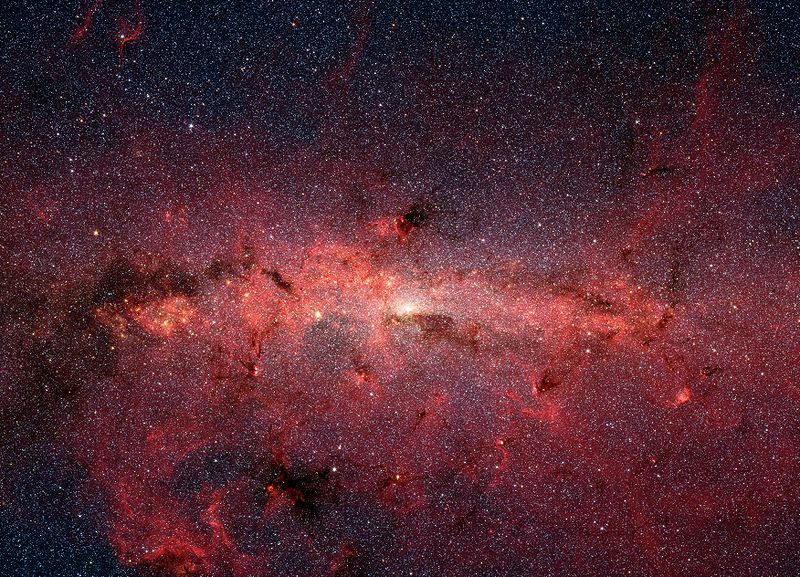
The Milky Way, or simply the Galaxy, is the galaxy in which the Solar System is located. It is a barred spiral galaxy that is part of the Local Group of galaxies. It is one of billions of galaxies in the observable universe.
Its name is a translation of the Latin Via Lactea, in turn translated from the Greek Γαλαξίας (Galaxias), referring to the pale band of light formed by the galactic plane as seen from Earth (see etymology of galaxy). Some sources hold that, strictly speaking, the term Milky Way should refer exclusively to the band of light that the galaxy forms in the night sky, while the galaxy should receive the full name Milky Way Galaxy, or alternatively the Galaxy.[4][5][6] However, it is unclear how widespread this convention is, and the term Milky Way is routinely used in either context.

NGC 5866 or Spindle Galaxy is a relatively bright lenticular galaxy in the constellation Draco. Some astronomers believe that the NGC 5866 may be a candidate for Messier 102. NGC 5866 was probably discovered by Pierre Méchain or Charles Messier in 1781, and independently found by William Herschel in 1788.
Spoiler for 1. THE SOMBRERO GALAXY:

The Sombrero Galaxy is an unbarred spiral galaxy in the constellation Virgo. It has a bright nucleus, an unusually large central bulge, and a prominent dust lane in its inclined disk. The dark dust lane and the bulge give this galaxy the appearance of a sombrero. The galaxy has an apparent magnitude of +9.0, making it easily visible with amateur telescopes. The large bulge, the central supermassive black hole, and the dust lane all attract the attention of professional astronomers.
Spoiler for 2. BLACK EYE GALAXY:

The Black Eye Galaxy was discovered by Edward Pigott in March 1779, and independently by Johann Elert Bode in April of the same year, as well as by Charles Messier in 1780. It has a spectacular dark band of absorbing dust in front of the galaxy's bright nucleus, giving rise to its nicknames of the "Black Eye" or "Evil Eye" galaxy. M64 is well known among amateur astronomers because of its appearance in small telescopes. It is a spiral galaxy in the Coma Berenices constellatio
Spoiler for 3. 2MASX J00482185-2507365/OCCULTING PAIR:

The galaxy was discovered by Caroline Herschel in 1783 while doing one of her systematic comet searches.About a half century later, John Herschel while at the Cape of Good Hope observed it using his 18 inch metallic mirror reflector. He then wrote "very bright and large (24′ in length); a superb object.... Its light is somewhat streaky, but I see no stars in it except 4 large and one very small one, and these seem not to belong to it, there being many near..."
In 1961, Allan Sandage wrote in the Hubble Atlas of Galaxies that the Sculptor Galaxy is "the prototype example of a special subgroup of Sc systems....photographic images of galaxies of the group are dominated by the dust pattern. Dust lanes and patches of great complexity are scattered throughout the surface. Spiral arms are often difficult to trace.... The arms are defined as much by the dust as by the spiral pattern." B. Y. Mills, working out of Sydney, discovered that the Sculptor Galaxy is also a fairly strong radio source.In 1998 the hubble space telescope took a close up of NGC 253.
Spoiler for 4. THE WHIRLPOOL GALAXY:

The Whirlpool Galaxy is an interacting grand-design spiral galaxy located at a distance of approximately 23 million light-years in the constellation Canes Venatici. It is one of the most famous spiral galaxies in the sky.[citation needed] The galaxy and its companion (NGC 5195) are easily observed by amateur astronomers, and the two galaxies may even be seen with binoculars.The Whirlpool Galaxy is also a popular target for professional astronomers, who study it to further understanding of galaxy structure (particularly structure associated with the spiral arms) and galaxy interactions.
Spoiler for 5. GRAND SPIRAL GALAXY:

NGC 3310 is a grand design spiral galaxy in the constellation Ursa Major. It is a starburst galaxy and its likely that NGC 3310 collided with one of its satellite galaxies about 100 million years ago, triggering widespread star formation. It is believed to be located approximately 46 million light-years away from the Earth, and is thought to be about 22000 light-years wide.
The ring clusters of NGC 3310 have been undergoing starburst activity for at least the last 40 Myr.
Spoiler for 6. SUPERNOVA 1987A:

SN 1987A was a supernova in the outskirts of the Tarantula Nebula in the Large Magellanic Cloud, a nearby dwarf galaxy. It occurred approximately 51.4 kiloparsecs from Earth, close enough that it was visible to the naked eye. It could be seen from the Southern Hemisphere. It was the closest observed supernova since SN 1604, which occurred in the Milky Way itself. The light from the supernova reached Earth on February 23, 1987. As the first supernova discovered in 1987, it was labeled "1987A". Its brightness peaked in May with an apparent magnitude of about 3 and slowly declined in the following months. It was the first opportunity for modern astronomers to see a supernova up close.
Spoiler for 7. GALAXY NGC 1512:

NGC 1512 is a barred spiral galaxy about 30 million light-years away in the constellation Horologium. It is a member of the Dorado Group
Spoiler for 8. GALAXY NGC 3370:

NGC 3370 nick named Silverado Galaxy is a spiral galaxy about 98 million light-years away in the constellation Leo. It is similar in size to our own Milky Way. NGC 3370 exhibits intricate spiral arm structure that is sprinkled with hot areas where new stars are forming. NGC 3370's center has well defined dust lanes and an unusually ill-defined nucleus. This galaxy contains a combination of young stars in the bluer regions and older stars in the yellowish core. The mass of NGC 3370 is estimated to be about the same as our own Milky Way at around 1011 solar masses.
Spoiler for 9. M81:

Messier 81 (also known as NGC 3031 or Bode's Galaxy) is a spiral galaxy about 12 million light-years away in the constellation Ursa Major. M81 is one of the most striking examples of a grand design spiral galaxy, with near perfect arms spiraling into the very center. Because of its proximity to Earth, its large size, and its active galactic nucleus (which harbors a supermassive black hole) Messier 81 is a popular galaxy to study in professional astronomy research. The galaxy's large size and relatively low apparent magnitude (lower magnitude implies higher brightness) also make it a popular target for amateur astronomy observations.
Spoiler for 10. HOAG’S OBJECT:

Hoag's Object is a non-typical galaxy of the type known as a ring galaxy. The appearance of this object has interested amateur astronomers as much as its uncommon structure has fascinated professionals. The galaxy is named after Arthur Allen Hoag who discovered it in 1950 and identified it as either a planetary nebula or a peculiar galaxy with 8 billion stars.
Spoiler for 11. Antennae Galaxies:

The Antennae Galaxies are a pair of interacting galaxies in the constellation Corvus. They were both discovered by Friedrich Wilhelm Herschel in 1785.
Spoiler for 12. Starburst galaxy:

A starburst galaxy is a galaxy in the process of an exceptionally high rate of star formation, compared to the usual star formation rate seen in most galaxies. Galaxies are often observed to have a burst of star formation after a collision or close encounter between two galaxies. The rate of star formation is so great for a galaxy undergoing a starburst that, if the rate was sustained, the gas reservoirs from which stars are formed would be used up on timescales much shorter than that of the galaxy. For this reason, it is presumed that starbursts are temporary. Well-known starburst galaxies include M82, NGC 4038/NGC 4039 (the Antennae Galaxies), and IC 10.
Spoiler for 13. Dwarf galaxy:

A dwarf galaxy is a small galaxy composed of up to several billion stars, a small number compared to our own Milky Way's 200-400 billion stars. The Large Magellanic Cloud, containing over 30 billion stars, is sometimes classified as a dwarf galaxy while others consider it a full-fledged galaxy going around the Milky Way galaxy.
Spoiler for 14. Milky Way/Bima Sakti:
Ini Dia Galaxy Tempat kita Tinggal

The Milky Way, or simply the Galaxy, is the galaxy in which the Solar System is located. It is a barred spiral galaxy that is part of the Local Group of galaxies. It is one of billions of galaxies in the observable universe.
Its name is a translation of the Latin Via Lactea, in turn translated from the Greek Γαλαξίας (Galaxias), referring to the pale band of light formed by the galactic plane as seen from Earth (see etymology of galaxy). Some sources hold that, strictly speaking, the term Milky Way should refer exclusively to the band of light that the galaxy forms in the night sky, while the galaxy should receive the full name Milky Way Galaxy, or alternatively the Galaxy.[4][5][6] However, it is unclear how widespread this convention is, and the term Milky Way is routinely used in either context.
Spoiler for 15. NGC 5866:

NGC 5866 or Spindle Galaxy is a relatively bright lenticular galaxy in the constellation Draco. Some astronomers believe that the NGC 5866 may be a candidate for Messier 102. NGC 5866 was probably discovered by Pierre Méchain or Charles Messier in 1781, and independently found by William Herschel in 1788.
Tidak ada komentar:
Posting Komentar